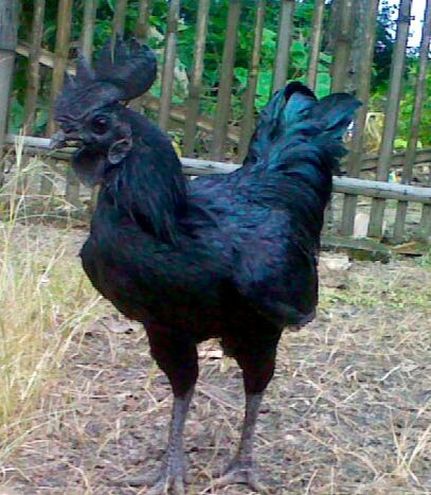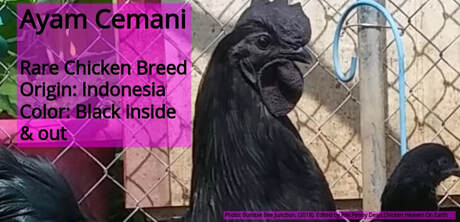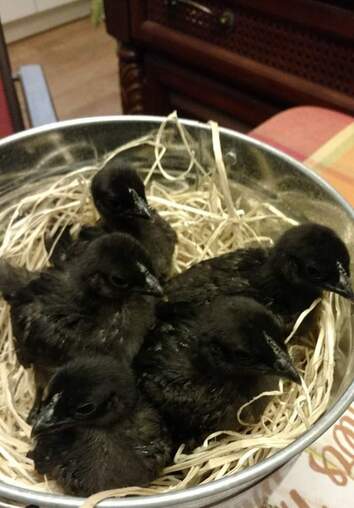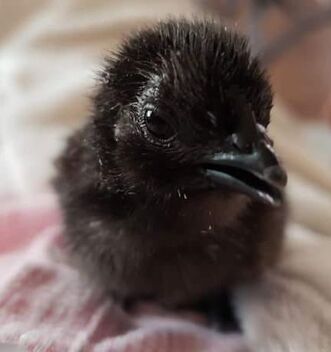Ayam Cemani-Black Chicken: Exotic & Rare Chicken Breeds
Pictures, video, and detailed information about the extremely rare exotic Ayam Cemani Chicken.These unique chickens are completely black inside and out due to a dominant gene which results in an overproduction of melanin which cause the dark skin color. These beautiful chickens are primarily used as ornamental birds.
Information About Ayam Cemani (Black Chicken-Inside & OUt)
 Photo By Kangwira - my farm, CC BY-SA 3.0, https://commons.wikimedia.org/w/index.php?curid=31158986
Photo By Kangwira - my farm, CC BY-SA 3.0, https://commons.wikimedia.org/w/index.php?curid=31158986
Appearance:The Ayam Cemani chickens combs, wattles, legs, feet, skin, bones, and internal organs are completely black. There blood is not black but is very dark in color. Feathers are black with brilliant beetle green and even purple highlights in the sun. (4)
Scroll down to see our featured video and more great stuff about Ayam Cemani chickens, and Ayam Cemani baby chicks for sale.
- Origin: Indonesia
- Egg Size and appearance: The eggs are typically large in comparison to the hens body size.
- The eggs are unusually large in proportion to the size of the hen’s body.and have a cream colored shell.
- Egg Production Yield: Approx. 60-80 eggs per yer
- Laying Cycle: Hens will lay 20-30 eggs during a three to six month laying cycle
Scroll down to see our featured video and more great stuff about Ayam Cemani chickens, and Ayam Cemani baby chicks for sale.
Featured Video: Ayam Cemani-Raising Rare Backyard Chickens
 Ayam Cemani. BumbleBee Junction. Feb. 2, 2018.
Ayam Cemani. BumbleBee Junction. Feb. 2, 2018.
In the following video: "Ayam Cemani chickens are considered the rarest breed of backyard chicken. Maintaining a large flock of this rare species here on the homestead has been very rewarding. They are originally from the island of Java in Indonesia where "Ayam" simply means "chicken" and "Cemani" is the name of the village they originate from. Fibromelanosis (FM) causes these birds to be entirely black in color. This is true of both the roosters and the hens. Their temperament seems more like a wild game bird than a domestic chicken. Otherwise, we take care of them the same as any other backyard chickens. As homesteaders, we are raising them primarily for the sale of both chicks and hatching eggs. We also raise and care for two other rare and semi-rare breeds, which we will discuss. One goal of homesteading is to strive for a self sufficient lifestyle. The income we derive from raising livestock and other domestic animals such as chickens helps with that goal. Please enjoy this look at the rarest of the rare, the Ayam Cemani chicken". --Bumble Bee Junction
How to tell if An Ayam Cemani Is Not A Pure Breed
 Pure Breed. Ayam Cemani Baby Chicks. Photo by Cindi Perry
Pure Breed. Ayam Cemani Baby Chicks. Photo by Cindi Perry
When purchasing Ayam Cemani chickens for breeding you will need to watch out for signs of mixed breeding as some unreputable breeders will mix the breeds to make a quick profit because Ayam Cemani's are very expensive. These birds should be black everywhere, skin, feathers, legs, wattles, comb, inside the mouth, and even the toenails. Always ask to see the parent birds when purchasing baby chicks.
Signs which indicate mixed breeding in Ayam Cemani's are:
Signs which indicate mixed breeding in Ayam Cemani's are:
- Red or mulberry coloring in the wattles or crown
- Any color other than black inside the mouth
- Clear toenails
- Feathers which have color bleeds (are not black or have another color in them) (BumbleBee Junction, 2018).
Ayam Cemani Baby Chicks For Sale
 Photo of Ayam Cemani Baby Chick by Cindi Perry
Photo of Ayam Cemani Baby Chick by Cindi Perry
Cindi Perry raises and sells high quality Ayam Cemani baby chicks.
For more information contact Cindi Perry:
Call: 803-413-9322
Be sure to tell her you heard about her from Chicken Heaven On Earth.
See more about Ayam Cemani below.
For more information contact Cindi Perry:
Call: 803-413-9322
Be sure to tell her you heard about her from Chicken Heaven On Earth.
See more about Ayam Cemani below.
Ayam Cemani Chicken Breeds Have Some Genetic Arrangements Which Are Identical to Chinese Silkies
"These genetic arrangements are identical in Cemani and Silkie, indicating a single origin of the genetic cause of Fm. The two DR1s harbor two distinct EDN3 haplotypes in a form of permanent heterozygosity, although they remain allelic in the ancestral Red Jungle Fowl population and some domesticated chicken breeds, with their allelic divergence time being as recent as 0.3 million years ago. In Cemani and Silkie breeds, artificial selection favoring the Fm phenotype has left an unambiguous record for selective sweep that extends in both directions from tandemly duplicated EDN3 loci. This highly homozygous tract is different in length between Cemani and Silkie, reflecting their distinct breeding histories. It is estimated that the Fm phenotype came into existence at least 6600–9100 years ago, prior to domestication of Cemani and Silkie, and that throughout domestication there has been intense artificial selection with strength s > 50% in each breed" (Dharmayanthi, A., Terai, Y., Sulandari, S., Zein, M., Akiyama, T., & Satta, Y. 2017)
References:
- Ayam Cemani - Raising Rare Backyard Chickens. (Feb. 2, 2018). YouTube. Retrieved 22 May 2019, from https://www.youtube.com/watch?v=arEPbZS2-gk
- Ayem Cemani. Wikipedia. https://en.wikipedia.org/wiki/Ayam_Cemani
- Photo: By Kangwira - my farm, CC BY-SA 3.0, https://commons.wikimedia.org/w/index.php?curid=31158986
- Ayam Cemani. Greenfire farms. https://greenfirefarms.com/ayam_cemani.html
- Header image. Ayam Cemani hen. (Oct. 30,2011). Photo submitted by Jeffrey Pamungkas. https://commons.wikimedia.org/wiki/File:Cemani.jpg
- Dharmayanthi, A., Terai, Y., Sulandari, S., Zein, M., Akiyama, T., & Satta, Y. (2017). The origin and evolution of fibromelanosis in domesticated chickens: Genomic comparison of Indonesian Cemani and Chinese Silkie breeds. PLOS ONE, 12(4), e0173147. doi:10.1371/journal.pone.0173147

